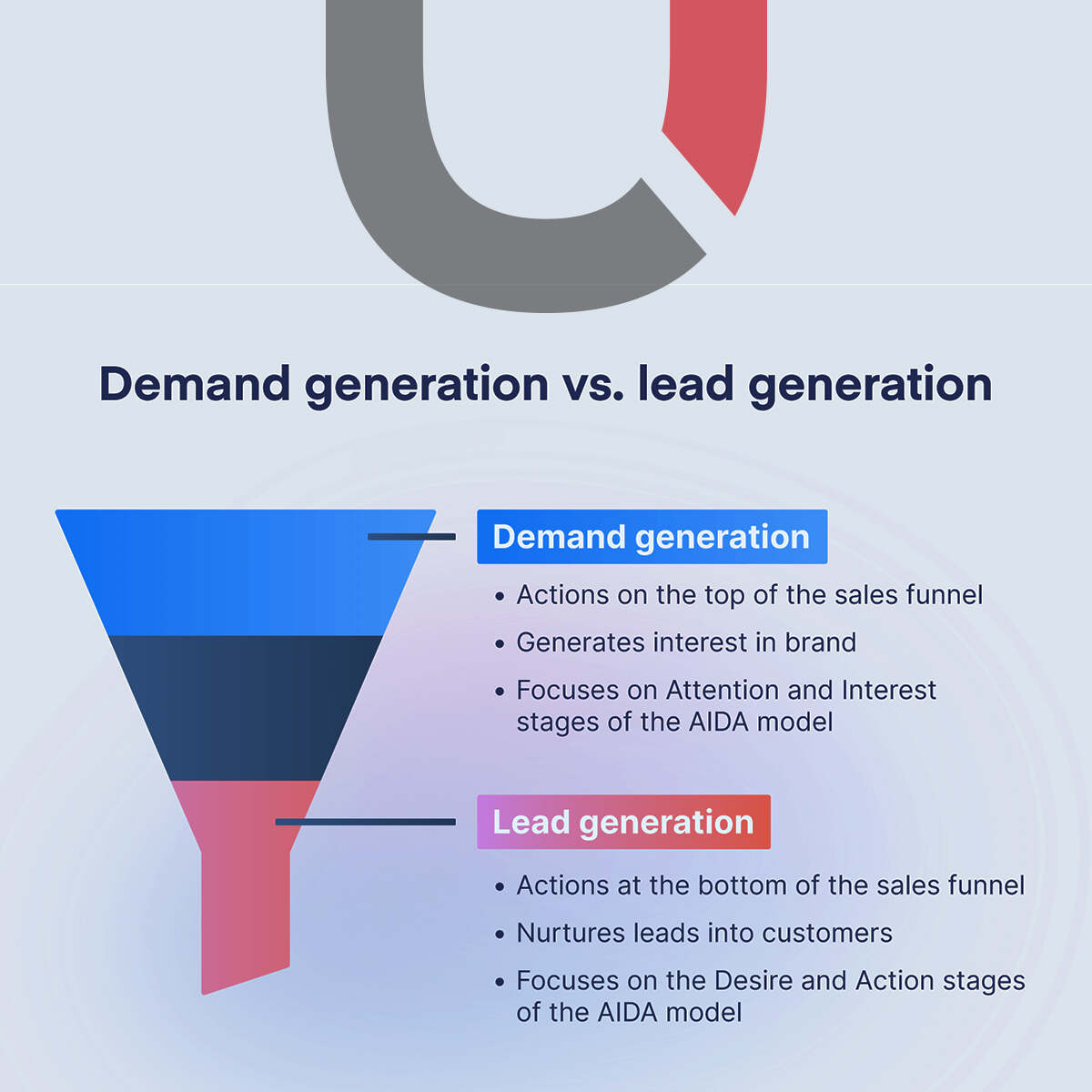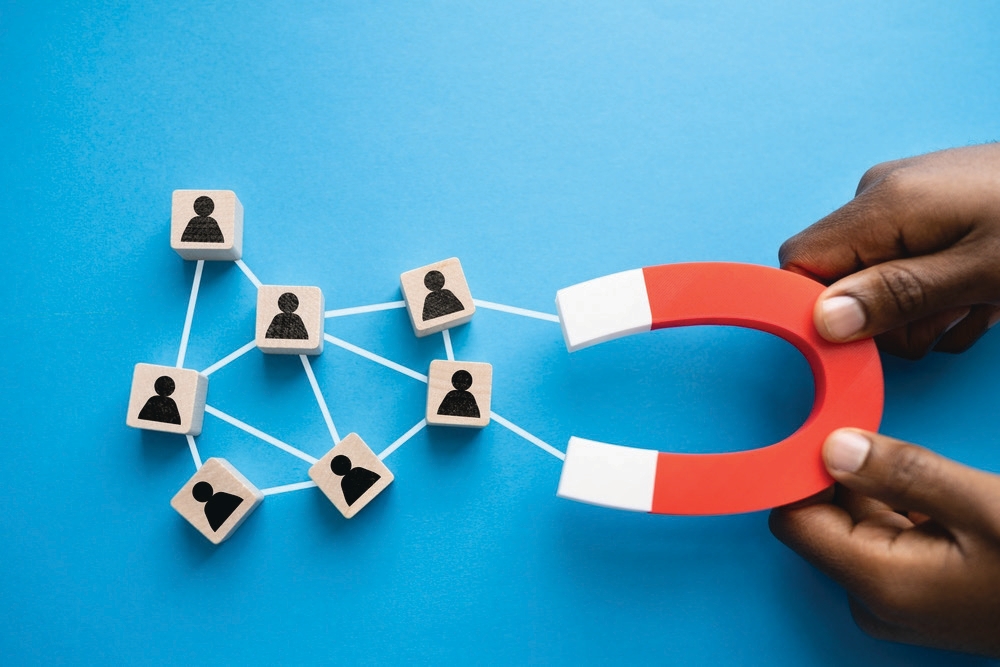Finding new and fresh customers is a headache for many businesses these days. It feels like shouting in a crowd, only in the hope that someone might hear you. You try to put out content and ads, hoping they will stick. That’s so old school, right? But what if I tell you a secret? What if you can taper your focus, not only grabbing attention but alluring people who are interested in what you offer? To understand this, it’s vital to learn lead generation vs demand generation.
In this blog, we’ll understand demand generation vs lead generation, their key differences, and how these 2 strategies work. At the end of this blog, we’re sure you will be loaded with actionable tips to improve your sales process. Stay till the end and get one step closer to B2B success.
What is Demand Generation?
Demand generation is the method of creating demand for your services or products. This method utilizes technology to cover every aspect of the buyer’s journey. Demand generation marketing is a game of patience. It’s all about flaming curiosity and interest in what you offer. If you are a person who wants quick wins, then demand generation is not for you. It’s about playing the long game and cherishing customers over time. You may have to invest a bit more effort in this strategy, but the long-term payoff will be huge. With persistent demand generation marketing, you will start to witness people talking about your brand. This will eventually lead to more competent leads and a boost in your sales.
Let’s understand this by an example. Suppose you post a funny social media post, and it goes viral. Millions of people see it but only a handful will be interested in your business or product. You’ve got attention (demand), but not all the viewers are your actual target audience. Nearly 49% of B2B marketers sing the praises of demand generation. Why? It helps them with high-quality leads, not just surfers.
What is Lead Generation?
Let’s learn about lead generation in a simple language. Demand generation vs lead generation are 2 different approaches. Demand generation can be your first move, and lead generation can be your second.
With the help of lead generation, you don’t have to start from scratch. Your target audience is already familiar with you, and your only motive is to turn them into your customers. The data you collect during the lead generation process is not just to fill your data bank. These data allow your sales team to learn more about the interested customer. It can help them figure out an ideal way to approach them. The main aim is to turn those leads into paying customers.
Still in doubt? Let’s learn through an example. Suppose you’re running a free webinar and teaching people how to get rid of a specific issue. Those who attend the webinar will undoubtedly be dealing with the same problem. This is called lead generation. Attracting people who are more likely to be your customers. In the year 2024, 50% of marketers considered lead generation to be their priority in marketing campaigns.
What are the Goals of Demand Generation?
There are many things you can achieve through demand generation apart from generating the initial interest. It’s an essential phase before heading towards lead generation.
Demand generation campaigns can help you in various ways:
Expands your reach
A demand generation campaign helps reach people who haven’t spotted you yet. This method attracts both familiar faces who may have missed your latest evolutions and also new customers who have just started to explore your industry. Placing your message across different channels helps increase brand awareness and bring in more potential customers.
Enhances your brand’s influence
A well-crafted demand generation campaign allows you to share groundbreaking ideas. By displaying your innovative solutions and highlighting your strengths, you can place yourself as a leader. This positions you trustable in the eyes of your customers, attracting people who value expertise and innovative approaches
Opens the way for lead generation
By promoting exciting new offers and curiosity about your brand, you give rise to a natural desire to explore further. This is the best opportunity to start lead generation. By providing valuable content like insightful articles or webinars, along with calls to action, you can turn that curiosity into qualified leads, paddling them down the sales funnel.
Nurtures and educates
An effective demand-generation campaign goes beyond simple promotion. It educates your audience about the value you offer. By explaining how your products or services address their pain points and challenges, you provide valuable knowledge. This builds trust and positions you not just as a seller but as a trusted partner who cares about their success.
What are the Goals of Lead Generation?
Lead generation campaigns are all about converting potential into profit. You can term it as a bridge between the spark flamed by demand generation and the satisfying final deal.
For a salesperson, diving in early, creating rapport with audiences, and caring about those relationships until customers are entirely ready to jump and buy. What’s the ultimate goal? A happy customer and a successful sale.
Apart from closing deals, you can achieve many things through lead-generation campaigns.
Extending your network
A stream of new and fresh leads makes sure your sales funnel stays filled, and your business keeps reaching new heights. But how to find fresh leads and build enduring connections? Continuously look out for collaborators, industry leaders, and potential clients at events. Try to build a connection that lasts long, exchange your business cards, and try to stay in touch with them.
Building loyalty and trust
By understanding more about your customers and customizing the approach to their requirements, you can build long-lasting connections. Think of them as a partner not as a one-time transaction. Building loyalty and trust is more than just demographics. Try to understand their goals and frustrations. This helps you personalize your communication to reach out to their emotional level. Always remember to treat your customers with empathy and respect.
Learning about your consumers
Every lead offers precious insights about their pain points and preferences. This helps you redefine your strategies. By learning about your customers’ pain points and preferences, you can build your strategies and gain optimal results. Try to pay attention to even minute things about your customers. Don’t forget to treat collected data as a compass, not as a map. No doubt, data analysis is vital but only use it to understand patterns and trends, not to replace human interaction.
Interacting with Customers
When a person takes time to register for a webinar or download any resource, they are indirectly showing their interest. Offer them personalized suggestions, follow up with them, and enhance your chances of getting potential customers. Showcase your appreciation and grab the opportunity to introduce yourself and the story of your brand. Don’t just try to push the information on them, invite them to be part of your community. Ask them to participate in polls, and contests, and also keep them updated through content campaigns.
What is Demand Generation vs Lead Generation
Both strategies are often connected to each other but are two different things. Let’s understand demand generation vs lead generation with the help of a table.
| Demand Generation | Lead Generation |
| The main motive is to make people aware of your brand, services, or products. | The main motive is to collect and bring in leads into your sales funnel and improve sales. |
| Demand generation marketing is targeted to a larger audience to increase the number of potential leads. | Lead generation marketing is targeted to specific audiences to increase the number of qualified leads. |
| The main work is to make people aware of the issues, requirements, and gaps that you can address. | The main work is to position yourself as the solution for the lead. |
| Content aims to build relationships, keep yourself on top in the minds, and place yourself as an industry leader. | Content aims to be more focused on conversations, capture the attention of leads, and encourage them to take a certain action. |
| Provides mainly free and demanded content to make it easily accessible to the target audience. | Provides mainly premium or lead magnet content to funnel robust leads. |
How do Demand and Lead Generation Work in Conjunction?
By understanding demand generation and lead generation strategies, it becomes clear that these processes are interlinked in a sales and marketing funnel. Demand generation creates the initial interest and awareness in potential customers, laying the foundation for lead generation activities to follow. Without an effective demand generation strategy, there may be a lack of sufficient leads entering the sales funnel. Conversely, without an efficient lead generation process, there is a risk of losing out on a substantial number of prospective customers.
It’s essential to recognize that lead generation is a continuation of demand generation marketing. Once the interest is sparked through demand generation, lead generation takes over to nurture and convert those interested opportunities into actual leads. This progression from demand to lead generation highlights the related nature of these strategies, both working together to guide potential consumers through the sales funnel.
Demand generation and lead generation are essential components of a marketing strategy, with demand generation establishing the groundwork for lead generation activities. As demand generation operates at the top of the sales and marketing funnel, it serves as the catalyst for building awareness and interest, while lead generation comes into play to capture, engage, and convert those leads into customers.
Conclusion
Well, demand generation vs lead generation are quite the same but are 2 different strategies. Both these strategies are a bit complex in detail, so it is crucial to find a suitable partner to not only guide you but also work with you hand in hand.
Marketboats has assisted thousands of satisfied clients with numerous funnels that generated unmatched results. With the help of countless demand and lead generation tools in our bag, we’re pretty confident we can help you gain the results you’re seeking to take your business to the next level. You’re just a click away to change the fortune of your business.






